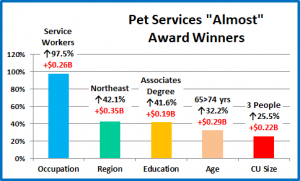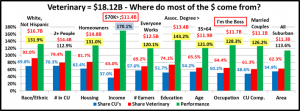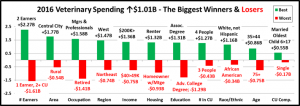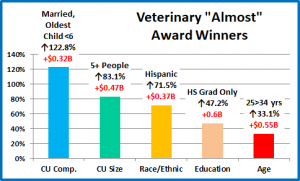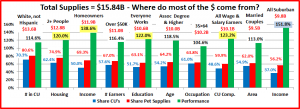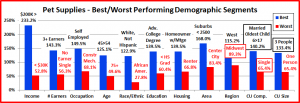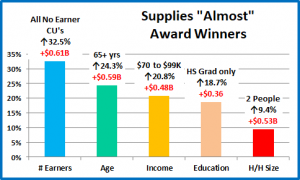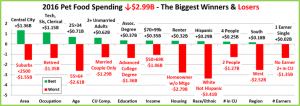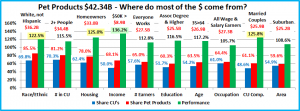2016 Pet Services Spending was $6.84B- Where did it come from…?
Now we will look at the last and smallest segment – Pet Services. We’ll see some similarities to other segments, especially Veterinary. However we’ll also see some big differences from the Product Segments and even from Veterinary. Each of these industry segments is unique. For one thing, Services spending is definitely more discretionary in nature than the other segments. This has resulted in CU income becoming the most dominant factor in spending behavior. We’ll see the impact of this in many demographic categories. We have seen some big spending swings in the other Industry Segments in the last 2 years. Services Prices have also been inflating at a rate that is below Veterinary, but much higher than the product segments. Thus far, at least on the surface, neither of these factors has affected the consistent annual growth in spending $ that Services has enjoyed since 2011. Let’s look a little deeper.
Let’s start by identifying the groups most responsible for the bulk of Services spending in 2016 and the $0.58B increase. The first chart details the biggest Pet Services spenders for each of 10 demographic categories. It shows their share of CU’s, share of pet products spending and their spending performance (Share of spending/share of CU’s). The differences from the other segments are immediately apparent. In order to better target the bulk of the spending we had to alter the groups in four categories – income, education, age and occupation. The performance level should also be noted as 7 of 10 groups have a performance level above 120%. This compares to 8 for Veterinary, 5 for Supplies and only 4 for Food. These big spenders are performing well but it also indicates that there is a large disparity between the best and worst performing segments. Income is absolutely the biggest factor in Services Spending. The categories are presented in the order that reflects their share of Total Pet Spending which highlights the differences of the 6 matching categories.
- Race/Ethnic – White, not Hispanic (86.8%) This large group accounts for the vast majority of spending in every segment. With a 124.3% performance rating, this category ranks #7 in terms of importance in Services Spending demographic characteristics. While Hispanics, African Americans and Asian American account for over 30% of U.S. CU’s, they only spend 13.2% of Services $. This is similar to their share of Food and Supplies – about 1% lower, but is 5% higher than their share of Veterinary Spending.
- Housing – Homeowners (85.7%) Homeownership is a major factor in pet ownership and spending in all industry segments. The Homeowners’ share of Pet Services spending is 85.7% which is the highest of any industry segment. However, even with 137.3% performance, homeownership is only in 4th place in terms of importance for increased Pet Services spending.
- # in CU – 2+ people (79.0%) The share of market for 2+ CU’s is very close for all segments. Their overall Pet Services performance of 112.4% is next to last. Spending is highest in 2>4 people CUs but drops off sharply for 5+ and singles.
- Education – College Grads (69.8%) Income generally increases with education. Services spending moves up strongly with each increasing level of education. This is what led us to shift the group up to College Grads. A performance of 171.7% makes a college education the 2nd most important factor in generating greater Services
- Occupation – “I’m the Boss” (69.2%) – The “ I’m the Boss” group consists of Mgrs & Professionals, Self-employed and retired CU’s. They have a slightly higher market share and a 30% higher performance than Total Wage & Salary earners. In fact their performance is 138.0% which puts them in 3rd This “bossy” group combines the 2 highest income groups with the strong performing retired group.
- Age – 45>74 (69.0%) Services Spending usually correlates with the 35>64 year olds, which includes the 3 highest income groups. However, this changed in 2016. The 35>44 group markedly increased their Veterinary spending and cut back on services. At the same time the 65>74 year olds decided to spend their money on needed services. The result was that the biggest spenders became the 45> 74 group. Their performance is 133.7% and ranks 6th of all the groups. The number is so high because the performances of all groups under 44 and the over 75 group are very low.
- # Earners – “Everyone Works” (67.4%) In this group, all adults in the CU are employed. Income is important so the relatively high market share is to be expected. However, their performance is 117.1%, which ranks only 8th in importance. This comes as a result of the strong year by retirees. It also shows that retirees and 1 earner CU’s with 2+ people spend a lot of money on Services – 32.6% of Total $. This similar to the pattern in Supplies.
- Income – Over $70K (66.7%) If we went down to the $50K income level, the market share would be 75.5%. However the $50>$69K income group only performs at 67.7%. Performance of CU’s in the $70>99K range goes up to 95.2% but it truly explodes over $100K – 232.2%. To get to the 60% market share goal we chose to group CU’s over $70K in income. This group has a performance rating of 180.2% and absolutely shows that CU income is the single most important factor in increased Pet Services Spending. However, we still have the spending anomalies of the overperforming, retired group and the underperforming, high income Asian Americans.
- CU Composition – Married Couples (66.0%) Married couples are a big share of $ and have 120+% performance in all segments. Their performance of 135.8% puts them in 5th place in terms of importance to Services spending.
- Area – Suburban (58.7%) Suburban CU’s spend the most $ but spending is balanced across all urban areas, including Central Cities. This is reflected by the low performance of 107.0% Rural areas are the only underperformers.
We changed 4 of the spending groups for Services to better target the biggest spenders. Higher income appears to be even more important to Services spending than it is to Veterinary, where we changed 2 groups. Services has 7 groups with performance over 120%. Veterinary has 8, but the performance levels in Services spending are markedly higher. This indicates an even bigger spending disparity between the segments in Services than exists in Veterinary.
Now, we’ll look at 2016’s best and worst performing Pet Services spending segments in each category.
Most of the best and worst performers are not a surprise. In Pet Services spending, there are 7 that are different from 2015, the most of any segment. 4 of them are in the worst category. This is similar to the Veterinary Segment which is also very dependent on higher income for increased spending. As we drill deeper into the data, we will see some similarities with other Industry segments but each Segment is unique. Changes from 2015 are “boxed”. We should note:
- Income is even more important to Pet Services. The 425.8% Performance by the $200K> group is 30.9% better than their performance in Veterinary and 126.1% higher than what they rang up in Food.
- # Earners – 3+ Earners – Last year they spent money on a food upgrade. This year they saved money on Food and spent more on everything else. They edged out 2 Earner CUs for the top spot. These highest income groups were the only segments with 100+% Services performance in the category.
- Age – 55>64 – These Baby Boomers made a big turnaround in 2016. They were up 54% in spending and made a major commitment to Pet Services. It makes sense. They are getting older so their need for services is growing but they still have the third highest CU income in this category so they have the money to pay for it.
- Education – <HS Grad – In the Services segment, this is the expected loser. In 2016, HS Grads occupied this spot.
- CU Composition – Single Parents finished last. In 2016 it was singles. These groups are invariably at the bottom. Married, Oldest Child <6 had a 54.7% increase and replaced Married Couples Only who had a 146.9% performance.
- # in CU –Singles – In 2016 all 2>4 People CUs improved their performance. The 5+ people and Single segments both had a significant decrease. Singles edged out last year’s loser, 5+ people, for the worst performance.
- Region – In 2015 the Midwest finished second with 122%. In 2016, they were the only Region with a decrease in Services spending, down $0.56B (-34% ) This left the West as the only region with 100+% performance.
It’s time to “Show you the money”. Here are segments with the biggest $ changes in Pet Services Spending.
Pet Services was up $0.58B for the 2nd year in a row. Despite this consistency, there was turmoil. There were only 2 repeat losers and 1 repeat winner from 2015. Also, 8 of the winners in 2015 were losers in 2016, while only 3 losers became winners. In 3 categories they just switched positions. This seems somewhat unusual for a segment with steady growth. Also, like Supplies, there was 1 category where all segments spent more. Here are the specifics:
- Housing – In 2015, spending increased for all segments. In 2016 only Homeowners without a mortgage spent more.
- Winner – Homeowner w/o Mtge – Services $: $2.25B; Up $0.78B (+53.5%)
- 2015: Homeowner w/Mtge
- Loser – Renter – Services $: $0.98B; Down $0.17B (-14.6%)
- 2015: Renter
- Comment – We see the impact of increased spending by the older groups and the decrease by the younger ones.
- Winner – Homeowner w/o Mtge – Services $: $2.25B; Up $0.78B (+53.5%)
- Education – Education above HS does matter as the increase was driven by Associates’ and Advanced Degrees.
- Winner – Adv. College Degree – Services $: $2.73B; Up $0.68B (+33.1%)
- 2015: BA/BS Degree
- Loser – BA/BS Degree – Services $: $2.04B; Down $0.25B (-10.9%)
- 2015: HS Grad only
- Comment – In 2015 College Grads, led by BA/BS holders fueled the increase. In 2016 the BA/BS group cut back on $ but the Advanced Degree segment more than made up the difference so College Grads are on top again.
- Winner – Adv. College Degree – Services $: $2.73B; Up $0.68B (+33.1%)
- Age – In 2015, the 25>54 group drove spending up. In 2016 the increase came from 55>74 year olds.
- Winner – 55>64 yrs – Services Spending: $1.89B; Up $0.66B (+54.0%)
- 2015: 35>44yrs
- Loser – 35>44 yrs – Services Spending: $0.9B; Down $0.29B (-24.6%)
- 2015: 55>64 yrs
- Comment: We see the impact of other categories and $. The big winners in 2015, the 25>44 group, changed their focus in 2016. The 25>34 yr olds spent more on Food and Veterinary. The 34>45 group turned to Veterinary and Supplies. Both now have more balanced pet spending. The 55>74 group began value shopping for Food in 2016 and spent a lot of the saved money on Services. Only the high income 45>54 group had an increase in both years.
- Winner – 55>64 yrs – Services Spending: $1.89B; Up $0.66B (+54.0%)
- Area Type – Central Cities has two consecutive years of increases totaling $0.99B
- Winner – Central City – Services Spending: $2.54B; Up $0.66B (+34.8%)
- 2015: Suburbs 2500>
- Loser – Suburbs 2500> – Services $: $3.28B; Down $0.16B (-4.5%)
- 2015: Rural
- Comment – The Suburbs 2500> didn’t have a good year. They spent less in Services and in fact, all pet segments.
- Winner – Central City – Services Spending: $2.54B; Up $0.66B (+34.8%)
- Region – All regions but the Midwest showed increases in 2016. In 2015 all regions showed growth.
- Winner – West – Pet Services Spending: $2.36B; Up $0.55B (+30.5%)
- 2015: Midwest
- Loser – Midwest – Services Spending: $1.09B; Down $0.56B (-34.0%)
- 2015: Northeast
- Comment – The West is up $0.76B since 2014. Only the Midwest has a decrease from 2014, down $0.25B.
- Winner – West – Pet Services Spending: $2.36B; Up $0.55B (+30.5%)
- Occupation – In 2015 the higher income jobs led the way. In 2016 it was the lower income jobs, plus self-employed.
- Winner – Retired– Services Spending: $1.39B; Up $0.5B (+56.8%)
- 2015: Mgrs. & Professionals
- Loser – Mgrs. & Professionals – Services: $2.39B; Down $0.26B (-9.9%)
- 2015: Retired
- Comment – The Retired and Service worker groups had a huge turnaround from down $0.35B in 2015 to up $0.76B in 2016. The Mgrs and Tech worker groups went the other direction from up $0.82B to down $0.37B. All 4 groups are up from 2014. The Self-employed group is the only segment with increases in both 2015 and 2016.
- Winner – Retired– Services Spending: $1.39B; Up $0.5B (+56.8%)
- Race/Ethnic – The White, Non-Hispanics share of Supplies spending is 86.8% so even a 7.5% increase is a winner.
- Winner – White, Not Hispanic – Services $: $5.93B; Up $0.41B (+7.5%)
- 2015: White, Not Hispanic
- Loser – African American – Services $: $0.24B; Up $0.02B (+11.3%)
- 2015: African American
- Comment – In 2016 all racial/ethnic groups spent more on Services. This is somewhat of a surprise in a segment which is so driven by income. The Asians had the biggest percentage increase at 29.1%. The African Americans finished last 2 years in a row but at least in 2016 it was for the lowest increase, not the biggest decrease.
- Winner – White, Not Hispanic – Services $: $5.93B; Up $0.41B (+7.5%)
- Income – 2016 was a year of mixed messages as the $30 to $49K group won – largely driven by the retirees.
- Winner – $30 to $49K – Services Spending: $0.92B; Up $0.40B (+78.6%)
- 2015: $150K>
- Loser – $70 to $99K – Services $: $0.91B; Down $0.08B (-8.0%)
- 2015: $70 to $99K
- Comment – The 2 year drop from $70>99K reflects the changing spending behavior of the various demographic category segments which fall into this upper middle income group.
- Winner – $30 to $49K – Services Spending: $0.92B; Up $0.40B (+78.6%)
- # in CU – A big turnaround for the winner which reflects the spending of all Married Couples with children.
- Winner – 4 People – Services Spending: $1.04B; Up $0.34B (+48.2%)
- 2015: 1 Person
- Loser – 1 Person – Services Spending: $1.43B; Down $0.21B (-12.8%)
- 2015: 4 People
- Comment: In 2016 2>4 people CU’s spent more. All others spent less. In 2015 the increase came from the 1>3 people CU’s as singles “stepped up”. Only the 5+ group spent less for 2 consecutive years. Financial pressures?
- Winner – 4 People – Services Spending: $1.04B; Up $0.34B (+48.2%)
- # Earners – In 2016 every segment but 1 earner, singles spent more.
- Winner – 2 Earners – Services Spending: $2.86B; Up $0.34B (+13.6%)
- 2015: 1 Earner, Single
- Loser – 1 Earner, Single – Services $: $0.93B; Down $0.29B (-23.9%)
- 2015: 2+ in CU with 1 Earner
- Winner – 2 Earners – Services Spending: $2.86B; Up $0.34B (+13.6%)
- Comment – In 2015 only CU’s where all adults worked spent more. In 2016, the retired folks and 2+ CU’s with only 1 earner also got on board the increase “Train”. Only the single workers were left at the station with a decrease.
- CU Composition – Every CU with 2 or more adults, with or without children spent more on Services in 2016.
- Winner – Married Couple Only – Services: $2.17B; Up $0.17B (+8.4%)
- 2015: Single
- Loser – Single – Services $: $1.43B; Down $0.21B (-12.8%)
- 2015: Unmarried, 2+ Adults
- Comment – Increased Pet Services spending was very widespread across this demographic category. Only CU’s with single adults or single parents spent less.
- Winner – Married Couple Only – Services: $2.17B; Up $0.17B (+8.4%)
We’ve now seen the winners and losers in terms of increase/decrease in Pet Services Spending $ for 11 Demographic Categories. Overall, 2016 was a year with much stronger and more widespread gains than losses. The winning increase in each category averaged +56% while the biggest decreases averaged -16%. We saw strong contributions from the 55 to 74 age group, the Central City and the West. The $0.58B increase matched 2015 and was the 5th consecutive increase, totaling $2.5B (+56.5%). Like the other Pet Segments, not every good performer can be “the” winner and some of these hidden segments should be recognized for their outstanding performance. They don’t win an award but they deserve…
Honorable Mention
Pet Services spending was up $0.58B in 2016. The increase was in tune with the segment’s performance since 2011. It was relatively demographically widespread as 49 of 82 segments (59.8%) spent more on Services. These “almost” winners reinforce the contributions of the older folks, families and Central Cities. We also see that you don’t have to have a big income or a Master’s Degree to buy Pet Services. These 5 segments aren’t award winners but their combined Services spending increase was significant at $1.31B.
Summary
In 2015 and 2016, significant changes in spending behavior for Pet Food first negatively affected, then positively affected spending in the Supplies and Veterinary segments. Through this turmoil, Services spending seemed unfazed, quietly registering a $0.58B increase in both years. The increase was relatively widespread with 60% of all demographic segments registering an increase. Also, all segments in the Racial/Ethnic category increased spending on Services
Pet Services are definitely needed by some groups. However, for most demographics, Services are a convenience and spending is very discretionary in nature. The result of this is that CU income is of paramount importance to increased Services spending. This impacts many demographic categories and we adjusted the big spender groups in 3 categories specifically to accommodate this difference in behavior and to better target where most of the $ are coming from. Just how important is income? 37% of CU’s have an income over $70K and account for 66.7% of Services Spending. This is a performance rating of 180.7% – the highest rating earned by any group in any category in any industry segment.
Performance is an important measurement. Let’s drill deeper into the performance of the big spenders in Pet Services. We identified 5 demographic categories with high performing large groups. (There were 6 for Veterinary and 3 for Food)
- Income
- Occupation
- Higher Education
- Homeownership
- CU Composition
The biggest producers in these groups all generate increased Services $ and all are categories in which the consumer can exercise some degree of control. The Racial/Ethnic and Age Categories also have high performance numbers but the consumer has no control over their inclusion in these groups. All 5 of these groups have a performance above 133%. This is incredibly high and indicates a huge disparity between the best and worst performing segments in the category. This disparity is greater in Services than in any other Industry segment. On the one hand this is good news as it makes it easier for industry participants to more effectively target their best customers. It also allows them to identify those demographic segments most in need of improvement. Unfortunately, these lowest performing groups may need considerable assistance.
There was definite turmoil in this income driven segment. There were 7 changes in the best and worst performing individual segments but the biggest changes showed up in $. 19 of 22 winners and losers in spending $ were different from 2015. In fact 8 2015 winners became losers in 2016, while 3 losers became winners. There were also some surprising winners, like the Retirees, Central City and the $30>49K income group. There were 2 major trends of note:
- The “older” movement – The biggest increases came from the 55>74 age groups.
- The Urbanization of the U.S. is reflected in Services with strong spending growth by Central City.
Finally – The “Ultimate” Pet Services Spending Consumer Unit consists of 2 people – a married couple, living alone now that their last child finally moved out. They are in the 55 to 64 age range. They are White, but not of Hispanic origin. At least one of them has an advanced College Degree. Both of them work, running their own business. They’re doing well with an income over $200K. They still live in a larger suburb, near a big city in the Western U.S. and are still paying off the mortgage on their home.





